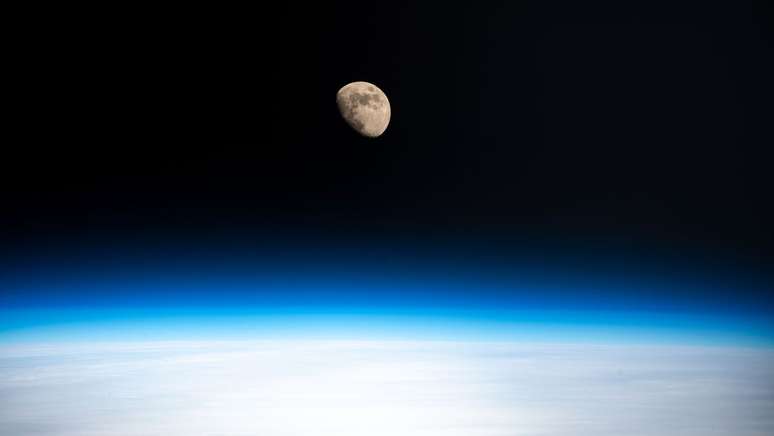Have you noticed that many photos taken in space show only darkness in the background, without a single star? Find out why this happens!
Normally, photos taken on the Moon or the International Space Station do not show the stars: only deep darkness occupies the background of the images. The explanation for this is relatively simple, but takes some understanding principles of photography and the behavior of light.
- 10 tips for taking the best photos of the sky and stars with your mobile phone
- What is it like to see the Earth from space? Watch the video recorded on the Chinese space station!
Is it possible to see stars in space?
Before explaining why there are no stars in space photos, it’s worth clarifying that yes, it is possible to see stars in the midst of darkness in space. They simply don’t appear in most photographs, but are visible to astronauts’ eyes – and in far greater numbers than we see here on the surface.
Watch this beautiful record of astronaut Jack Fischer, who was on the ISS in 2017. He decided to publish this time-lapse to answer followers’ constant doubts about whether or not they can see the stars on the ISS.
Can you see the stars from up here? Oh yeah baby! Check out the Milky Way as she spins and paints the skies in a thick coat of awesome sauce! pic.twitter.com/MsXeNHPxLF
—Jack Fischer (@Astro2fish) August 16, 2017
Where are the stars in the ISS photos?
Here on Earth, the atmosphere causes the sun’s rays to spread out and, therefore, throughout the day the sky is blue, clear and colorful. One might think that in space, since there is no atmosphere to scatter sunlight, the “sky” is always extremely dark, even at noon. And you are right, up to this point.
It’s just that the fact that the sky around an astronaut is dark even during the day doesn’t mean that he doesn’t get sunlight. In fact, an astronaut looking out the windows of the ISS during the day gets a lot of direct sunlight, as much (or even more) than we get on a summer day on the surface.

Here comes the knowledge of photography. She imagines being inside a house, in front of a sunny window, and wanting to photograph what is outside, receiving plenty of light. You will need to use a fast exposure and a very narrow aperture on your camera in order for the shot to be quick and accurate, capturing what is lit beyond the window, but not blasting that light.
And the principle for photographing large light contrasts in space is the same, as sunlight above the Earth illuminates everything as much as it does down here.
To take great photos of the Earth, the Moon, the metal structure of the ISS or astronauts’ suits, you need a fast exposure with a small aperture. Thus, a minimal amount of light reaches the camera sensors, enough to capture light from the brightest surface, in this case the Earth, Moon, ISS, etc.

Ok, but why don’t the stars appear in the background of the photo, since they stand out so much in the darkness of space? The reason is that very fast exposure captures the light of what is very bright in front of you, requiring a longer exposure time for the sensor to light up in order to record brighter objects that are further away and, therefore, weaker.
That is: when the camera setting is set to capture light from very bright foreground objects quickly, there isn’t enough time for the sensor to also record light from dimmer objects in the background.

And that’s why we see pictures with an astronaut “wandering” in the darkness of space, without a single star around him. His space suit is white and reflects a lot of sunlight. Therefore, the rationale for the photo to capture the astronaut’s image without breaking in light is the same.
And there are no stars on the moon?
The above explanation also applies to photos taken on the Moon, which clearly show landscapes, ships and astronauts, in contrast to a dark sky without a single star.
The lunar soil is highly reflective, requiring quick and accurate camera settings. Otherwise, the photo will explode where there is more light. However, this prevents the sensor from capturing the brightness of background stars.

Here on Earth, the rule is the same: for falling stars in the night sky, long exposures should be combined with wider apertures. This allows as much light as possible to enter the sensor, up to the point where it registers distant stars. However, if there is a minimally reflective object or surface in the same shot, all of the reflected light will be captured in the image, taking on the appearance of an unwanted bright “burst”.
And if you found this whole theory a bit complicated, here is the video suggestion below, in which the Sidereal Messenger delves into the matter and also exemplifies in a practical and visual way all the concepts explained here!
Trending on Canaltech:
- 45-year-old man spends 10 million reais a year to “go back” to 18
- Netflix reveals how it will block account sharing
- 5 spectral coordinates to visit using Google Maps
- Operation Big Hero wins a new manga in Brazil
- Advanced AI could wipe out humanity, Oxford researchers warn
- Who is Modok? Meet the bizarre Ant-Man and the Wasp: the villain of Quantummania
Source: Terra
Rose James is a Gossipify movie and series reviewer known for her in-depth analysis and unique perspective on the latest releases. With a background in film studies, she provides engaging and informative reviews, and keeps readers up to date with industry trends and emerging talents.






